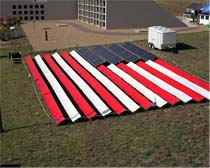Week in Review: Memorial Day weekend kicks off summer solar season
 Memorial Day weekend marks the unofficial beginning of summer in the U.S. Traditionally summer has also marked the beginning of the busiest season for solar installers. And it looks that trend may continue this year. The hottest debates of the summer season will likely remain the issue of fines on PV imports and falling incentives.
Memorial Day weekend marks the unofficial beginning of summer in the U.S. Traditionally summer has also marked the beginning of the busiest season for solar installers. And it looks that trend may continue this year. The hottest debates of the summer season will likely remain the issue of fines on PV imports and falling incentives.
There are multiple sides to recent preliminary U.S. Commerce Department is imposing on Chinese silicon PV duties. While the Coalition for American Solar Manufacturing and its members support the duties. Another group, the Coalition for Affordable Solar Energy (CASE), and its members opposed the duties. CASE includes installers and U.S.-based solar materials suppliers and heavy equipment manufacturers, like Hemlock Semiconductors and Dow Corning, that supply materials to Chinese PV manufacturers. The companies are worried about retribution from China and/or the lack of access to cheap modules for installers.
Meanwhile, companies like Sunrun are gearing up for the summer season. Most recently SunRun’s partners invested $60 million in equity financing to support expansion of its infrastructure and software platforms. SunRun is among the leading third-party ownership companies and the infrastructure spending will help it grow.
Similarly states are also gearing up for the summer season. Phoenix, Ariz., recently launched Solar Phoenix 2, a $25 million round of financing. The funding will help up to 1,000 homeowners in Phoenix that are members of the Salt River Project utility. Phoenix partnered with them and the National Bank of Arizona to offer solar leases with no up front costs. The systems leased through the Solar Phoenix 2 program will help participants save 10 precent to 15 percent per month on their electricity bills.
Vermont expanded its easy PV permitting program by making the permitting process accessible to systems up to 10 kilowatts in size from up to 5 kilowatts of size. Under the program, people in Vermont installing systems under 10 kilowatts of size can apply for the system with a simple permitting process that puts the onus on utilities to disallow a system’s installations within 10 days. If there is no protest, then the system can be installed.
The Capitol city also is trying to increase the amount of solar in its grid. DC Sun is lobbying Washington, D.C.’s City Council to adopt a bill allowing community solar gardens. Already the organization has collected more than two-thirds of the 750 signatures it’s seeking to support such a bill.
With the steep price drop in silicon PV leading to a glut of oversupply, you’d think all PV types are affected. That may not be the case. For instance, Solar Junction, which makes multi-junction gallium arsenide PV cells, is struggling to keep up with demand and will continue to do so even as new manufacturing comes online towards the end of 2012. The company’s cells are used in concentrating PV systems and are high demand.
Congenra Solar is adding more value to its hybrid solar systems by introducing the ability to use the sun to provide air conditioning. The company unveiled its first completed system, a 50.2 kilowatt PV array at the Southern California Gas Company's (SoCalGas) Energy Resource Center. One of the center’s chillers is now powered by a heat exchanger attached to Congenra’s solar thermal system. the sun.
image courtesy of NREL



